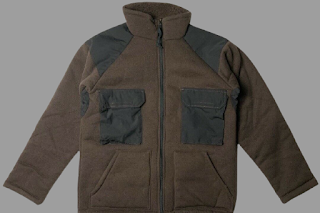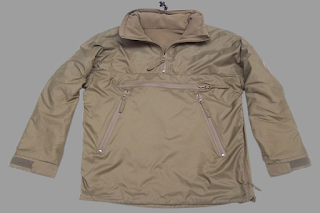...
From 1985
The Extended Cold Weather Clothing System was developed at the U.S. Army Natick and
was fielded for the Army and USMC by 1985.
..
https://olive-drab.com/od_soldiers_clothing_ecwcs.php
About
ECWCS is a Gore-tex parka and trousers plus a coordinated ensemble of additional underclothing and accessory items which can be optionally configured in many ways to provide cold weather protection in a wide variety of temperature (+40° F to -60° F), wind, and moisture conditions. ECWCS uses moisture management principles to transfer perspiration away from the skin, keeping the wearer warm and dry. ECWCS was intended to replace the many individual items of cold weather uniforms and clothing that preceeded it.
Items in this Section
Highlights
Anything Else
 We are, of course, interested in any other item that fits the collection, even if it is not listed here. If you have additional information, or if you have surplus equipment that you want to share, please contact us.
We are, of course, interested in any other item that fits the collection, even if it is not listed here. If you have additional information, or if you have surplus equipment that you want to share, please contact us.SELECTED ARTWORKS IN THE COLLECTION
....
History of development
Extended Cold Weather Clothing System (ECWCS)
The Extended Cold Weather Clothing System (ECWCS, pronounced ek-wax) was developed at the U.S. Army Natick Soldier Research, Development and Engineering Center, Natick, MA and was fielded for the Army and USMC by 1985.
Extended Cold Weather Clothing System (ECWCS)
The Extended Cold Weather Clothing System (ECWCS, pronounced ek-wax) was developed at the U.S. Army Natick Soldier Research, Development and Engineering Center, Natick, MA and was fielded for the Army and USMC by 1985.
PDF Manual : Here
1st Generation
The entire ECWCS ensemble (1st generation) consisted of : polypropylene
(1) undershirt and
(2) underwear [drawers],
(3)polyester fiberpile shirt and
(4) bib,
(5) nylon/cotton trousers,
(6) Gore-Tex parka and
(7) trousers,
(8)liners for the parka and
(9) trousers,
(10) white (snow camouflage) parka/trousers cover,
(11) gloves,
(12) glove inserts,
(13) mittens,
(14) mitten inserts,
(15) mitten shells,
(16) white mitten shells (snow camouflage),
(17) cap,
(18) balaclava,
(19) nylon socks, boots—both
(20) cold weather vapor barrier boots and
(21) extreme cold weather vapor barrier boots—and
(22) M-1950 trouser suspenders.
The system is to be used in an insulated, triple-layering fashion, with : the polypropylene undergarments as Layer 1, the polyester shirt/bib, liners and cotton/nylon trousers as Layer 2, and Gore-Tex outer garments as Layer 3.
The parka and trousers (which have been adapted to the civilian outdoor clothing market) are themselves constructed in a three-layer fashion consisting of an outer layer of abrasion-resistant taslan nylon, an intermediate layer of durably waterproof, windproof, and Gore-Tex membrane (protected with a layer of nylon tricot and originally in a four-color camouflage print), and a hung inner layer of unlaminated nylon. The whole is seam-sealed.
The ECWCS Parka
The parka — which is a particularly popular component — is characterized by a cobra hood (which fits over a combat helmet) with woven nylon drawstringadjustable pulls and an attachment piece that allows fastening of a fur ruff (early models of the parka lacked this attachment piece). There is a two-way, full-front slide fastener to provide full-face protection, leaving only the eyes uncovered. The parka has Raglan shoulders/sleeves, a non-freezing, double-pull zipper withstorm flap and seven snap closure, a flap-covered pocket on the left sleeve with hook and loop (Velcro) closure, adjustable hook and loop wrist cuffs, armpit ventilation zippers and double reinforced elbows. A badge/insignia tab with snap is located on the storm flap. There is an interior back ventilation opening, two slash (handwarmer) cargo pockets on the lower front (with extra large flaps and double hook and loop single snap closure on each) and an inside draft skirt (windskirt) with elastic drawcords and barrel-locks at the waist (without pulls). There are also two concealed map pockets at the front zipper with hook and loop closures that can be opened without unzipping the parka.
Unfortunately, due to the limitations of "waterproof-breathable" fabric, the parka did not breathe well in field use by active troops.
....
Nomenclature
History
In the 1980s, material technology developed significantly. Gore-Tex vapor-permeable fabric appeared, which was massively used in tourist jackets. Such jackets found their way into the hands of special forces soldiers, which drew attention to the need to introduce new uniforms. The first series of jackets in the Woodland camouflage pattern was manufactured to the order of a group of officers from the 9th Infantry Division of the US Army. The first official US Army Gore-Tex jackets were produced in 1985. The system consisting of several elements was called ECWCS (Extended Cold Weather Clothing System). Gore-Tex jackets have replaced not only winter uniforms, but also rain kits.
Specification
Logistic
Specifications
SELECTED ARTWORKS IN THE COLLECTION
....
A. GENERAL. The ECWCS is composed of 23 individual clothing, handwear, headwear and footwear items which are used in various combinations to meet cold weather environmental requirements. Appendix A (pages 48 to 52) lists ECWCS component items in layering order and identifies available sizes and the prescribed temperature range for each item.
1. Sequence. The ECWCS is an insulating system
consisting of the following five primary layers (including the overwhites, when necessary) and accessories:
Layer 1 - Polypropylene undershirt and
drawers.
Layer 2 Bib overall, cold weather shirt
and trouser liner.
Layer 3 - Coat liner and field trousers.
Layer 4 - Extended cold weather
camouflage parka and trousers.
Layer 5 - Snow camouflage parka and
trousers (overwhites).
Accessories - Handwear, headwea
Generations
Elements of the ECWCS gen. I system
Polypropylene underwear
From 1985 to the present day, three generations of the ECWCS system were created. Each generation provided comfort within the temperature range of 4 ° C to –51 ° C [1] [2].
First generation
The so-called the first generation consisted of several levels:
Level 1. Polypropylene underwear (T-shirt + pants). The collar of the sweatshirt has a quite characteristic cut, referred to as "Turtle Neck" - lower at the back, reaching the user's chin at the front. The whole thing is tight, well fitting to the body, the color of coffee and milk - in the "regular" color of US Army underwear.
Level 2. Sweatshirt and Fleece Trousers (the so-called Bear Suit and Bear Trousers). The whole thing is made of thick polyester - smooth on the outside, with a texture resembling artificial, short fur on the inside. The set is chocolate-colored. The sweatshirt has a classic cut, it has 4 pockets. A characteristic feature of the pants is their length - they are designed so that they end above the shoe.
Level 3. Nylon linings from the M65 system. Filled with polyester wadding. They could be used interchangeably with level 2.
Level 4. Basic jacket (parka) and pants. Made of Gore-Tex fabric. The jackets and pants were made in two camouflages - Woodland and 3 Color Desert Pattern. The jacket had 4 pockets, including two inside the jacket, the so-called dry. She also had a snow skirt to prevent snow from getting under her clothes. The jacket was equipped with a permanent, spacious hood with a visor. A fur strip could be attached to it, which made the hood of the jacket similar to the hood of the M65 parka. The pants had no pockets, they only had grommets for classic pockets, e.g. in uniform pants.
Level 5. White winter masquerade (sweatshirt and pants). It was applied to level 4.
In addition, several accessories are provided for the system: arctic gloves (from the M65 system), gloves with a Goretex membrane, a balaclava (the so-called Balaclava) and a hat with earflaps. Black or white shoes, borrowed from the older M65 system, were also used (the so-called Mickey Mouse Boots).
The Parka, ECW, Camouflage has an integrated fabric hood. Another ECWCS component, added after initial fielding, was an attachable fur ruff (Ruff, Parka, Extended Cold Weather), MIL-R-44354. NSN range: 8415-01-315-9765 to 8415-01-315-9769, depending on size. The synthetic fur ruff has a wire rim, Velcro fasteners and snaps for the attachment of the ruff to the parka hood.
B. CLOTHING ITEMS.
1. Undershirt, Cold Weather, Polypropylene and
Drawers. Cold Weather, Polypropylene. The cold
weather underwear, which consists of the undershirt and drawers, are new ECWCS development
itemrs.
2. Shirt, Cold Weather, Polyester Fiberpile. The
cold weather shirt is a new ECWCS development item.
3. Overall, Bib, Cold Weather, Fiberpile. The
bib overall is a new ECWCS development item.
4. Liner, Cold Weather, Trousers, Field and
Liner, Cold Weather, Coat, Men's. The full closure,
cold weather trouser liner and the coat liner are
standard items used in ECWCS.
5. Trousers, Cold Weather, Field, Nylon and
Cotton. The olive green or the four color caimouflage
printed cold weather field trousers are standard
items used in ECWCS.
6. Parka, Extended Cold Weather, Camouflage.
the extended cold weather camouflage parka is a new
ECWCS development item.
7. Trousers, Extended Cold Weather,
Camouflage. The extended cold weather camouflage
trousers are a new ECWCS development item.
8, Parka, Snow Camouflage and Trousers, Snow
Camouflage. The snow camouflage parka and trousers are standard items used in ECWCS.
HANDWRAR. The ECWCS standard handwear
items are: glove inserts, gloves, mitten inserts,
mitten shells (cold weather and snow camouflage),
and mitten set.
1. Gloves, Insert, Cold Weather.
2. Gloves, Men's and Women's, Light Duty.
3. Mitten Inserts. Cold Weather (Trigger Finger).
4. Mitten Shells, Cold Weather (Trigger Finger).
5. Mitten Set, Extreme Cold Weather.
6. Mitten Shells, Snow Camouflage, Cotton,
White, Two Finger.
D. HEADWEAR. There are two headwear items in
the ECWCS: the cap, combat, camouflage with earflaps and the balaclava (hood).
1. Cap, Camouflage Pattern.
2. Hood, Combat Vehicle Crewman's (Balaclava).
E. FOOTWEAR. The ECWCS footwear consists of
three items: the cushion sole, wool socks, and the
extreme cold weather boots (black and white).
1. Socks, Men's, Nylon, Cushion Sole, Stretch
Type, OG-106.
2. Boots, Cold Weather (Type I-Black).
3. Boots, Extreme Cold Weather (Type II-White).
F. ACCESSORIES.
1. Suspenders, Trousers, M-1950.
The Suspenders, Trousers, M-1950 (MIL-S-10926) are also part of ECWCS, used with the Trousers, Extended Cold Weather, Camouflage.The Parka, ECW, Camouflage has an integrated fabric hood. Another ECWCS component, added after initial fielding, was an attachable fur ruff (Ruff, Parka, Extended Cold Weather), MIL-R-44354. NSN range: 8415-01-315-9765 to 8415-01-315-9769, depending on size. The synthetic fur ruff has a wire rim, Velcro fasteners and snaps for the attachment of the ruff to the parka hood.













.JPG)
.jpg)
.jpg)
.jpg)
.jpg)
.jpg)
.jpg)
.jpg)

No comments:
Post a Comment